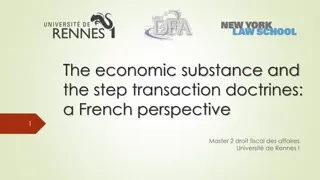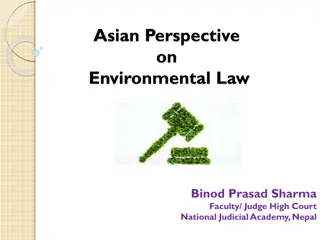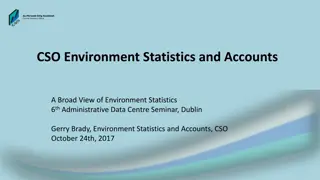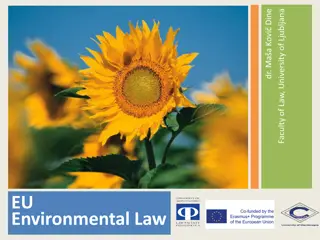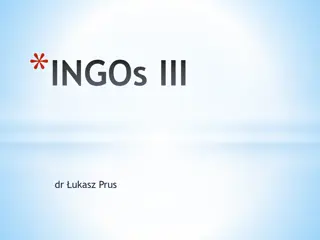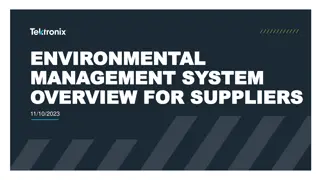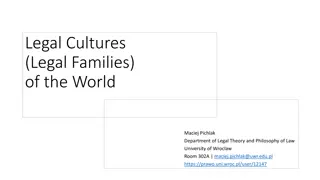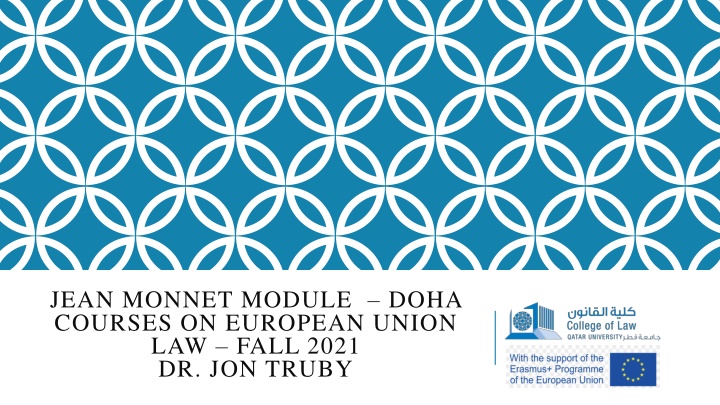
EU Water Protection Directives and Frameworks for Sustainable Resource Management
Discover the importance of water protection and management in the European Union, guided by directives like the Water Framework Directive (WFD) and the Marine Strategy Framework Directive (MSFD). Learn about strategies, achievements, and specific initiatives aimed at safeguarding Europe's water resources and promoting sustainable water use.
Download Presentation

Please find below an Image/Link to download the presentation.
The content on the website is provided AS IS for your information and personal use only. It may not be sold, licensed, or shared on other websites without obtaining consent from the author. If you encounter any issues during the download, it is possible that the publisher has removed the file from their server.
You are allowed to download the files provided on this website for personal or commercial use, subject to the condition that they are used lawfully. All files are the property of their respective owners.
The content on the website is provided AS IS for your information and personal use only. It may not be sold, licensed, or shared on other websites without obtaining consent from the author.
E N D
Presentation Transcript
JEAN MONNET MODULE DOHA COURSES ON EUROPEAN UNION LAW FALL 2021 DR. JON TRUBY
Water Protection and Management
Introduction Water is essential for human, animal and plant life and for the economy. Its protection and management transcend national boundaries. The EU Water Framework Directive (WFD) establishes a legal framework to protect and restore clean water in the EU and to ensure its long-term sustainable use. It is complemented by more specific legislation, such as the Drinking or Bathing Water Directive, the Floods Directive and the Marine Strategy Framework Directive, as well as by international agreements.
General Background In 2012, the Commission launched the Blueprint to Safeguard Europe s Water Resources, a long-term strategy that aims to ensure the availability of a sufficient level of quality water for all legitimate uses by better implementing current EU water policy, integrating water policy objectives into other policy areas, and filling gaps in the current framework. It envisages the establishment by the Member States of water accounts and water efficiency targets, as well as the development of EU standards for water reuse.
Achievements EU policy has established two main legal frameworks for the protection and management of our freshwater and marine resources in an eco- system-based, holistic approach: 1. The Water Framework Directive (WFD) 2. the Marine Strategy Framework Directive (MSFD).
Water Framework Directive (WFD) and Specific Supporting Water Directives The EU Water Framework Directive establishes a framework for the protection of inland surface waters, transitional waters, coastal waters and groundwater. It aims to prevent and reduce pollution, promote sustainable water use, protect and improve the aquatic environment and mitigate the effects of floods and droughts. Member States are therefore requested to draw up so-called River Basin Management Plans based on natural geographical river basins, as well as specific programmes of measures to achieve the objectives.
Water Framework Directive (WFD) and Specific Supporting Water Directives The WFD is supported by more targeted directives, - Groundwater Directive - Drinking Water Directive - Bathing Water Directive - Nitrates Directive - Urban Waste Water Treatment Directive - Environmental Quality Standards Directive - Floods Directive
Groundwater Directive The directive on the protection of groundwater against pollution and deterioration provides for specific criteria for The assessment of good chemical status, the identification of significant and sustained upward trends, and the definition of starting points for trend reversals. All threshold values for pollutants (with the exception of nitrates and pesticides, for which the limits are set by specific EU legislation) are set by the Member States.
Revised Drinking Water Directive The revised Drinking Water Directive of 2020 defines essential quality standards for water intended for human consumption. It requires Member States to regularly monitor the quality of water intended for human consumption by using a sampling points method. Member States can include additional requirements specific to their territory but only if this leads to setting higher standards. The directive also requires the provision of regular information to consumers. Furthermore, the quality of drinking water has to be reported to the Commission every three years.
Revised Drinking Water Directive The revised directive was proposed by the Commission on 1 February 2018, in response to the European Citizens Initiative Right2Water , replacing the previous directive of 1998. The revised directive updated existing safety standards and improved access to safe drinking water along the lines of the latest recommendations of the World Health Organization. It increases transparency for consumers on the quality and supply of drinking water, thereby helping to reduce the number of plastic bottles through increased confidence in tap water.
Bathing Water Directive The Bathing Water Directive aims to enhance public health and environmental protection by laying down provisions for the monitoring and classification (in four categories) of bathing water and informing the public about it. During bathing season, Member States have to take samples of bathing water and assess the concentration of at least two specific bacteria once a month at each bathing water site. They have to inform the public through bathing water profiles containing for instance information on the kind of pollution and sources that affect the quality of the bathing water.
Environmental Quality Standards Directive The Environmental Quality Standards Directive establishes limits on concentrations of 33 priority substances presenting a significant risk to, or via, the aquatic environment at EU level and eight other pollutants in surface waters. During a review, 12 new substances were added to the existing list and an obligation was introduced for the Commission to establish an additional list of substances to be monitored in all Member States (watch list) to support future reviews of the priority substances list.
Urban Waste Water Treatment Directive The Urban Waste Water Treatment Directive aims to protect the environment from the adverse effects of urban waste water discharges and discharges from industry. The directive sets minimum standards and timetables for the collection, treatment and discharge of urban waste water, introduces controls on the disposal of sewage sludge, and requires the dumping of sewage sludge at sea to be phased out. The Commission is intending to update this directive, to better counter water scarcity by facilitating the reuse of treated waste water for agricultural irrigation.
Nitrates Directive The Nitrates Directive aims to protect waters from nitrates from agricultural sources. A complementary regulation requires Member States to send a report to the Commission every four years, providing details of codes of good agricultural practice, designated nitrate vulnerable zones (NVZ), water monitoring and a summary of action programmes. Both the directive and the regulation aim to safeguard drinking water and prevent damage from eutrophication.
EU Floods Directive The EU Floods Directive aims to reduce and manage the risks posed by floods to human health, the environment, infrastructure and property. It requires Member States to carry out preliminary assessments to identify the river basins and associated coastal areas at risk and then prepare flood risk maps and management plans focused on prevention, protection and preparedness. All of these tasks are to be carried out in accordance with the WFD and the river basin management plans set out therein.
EU Coastal and Marine Policy
The Marine Strategy Framework Directive The Marine Strategy Framework Directive (MSFD) is the environmental pillar of the EU s Integrated Maritime Policy (IMP), which was set up with a view to enhancing the sustainable development of its maritime economy while better protecting its marine environment. The objective of the MSFD was to reach good environmental status (GES) of the EU s marine waters by 2020, to continue its protection and preservation, and to prevent subsequent deterioration. It establishes European marine regions (the Baltic Sea, the North-east Atlantic Ocean, the Mediterranean Sea and the Black Sea) and sub-regions within the geographical boundaries of the existing Regional Sea Conventions.
The Marine Strategy Framework Directive In order to achieve GES by 2020, Member States had to develop ecosystem-based strategies for their marine waters, to be reviewed every six years. A regulation on Integrated Coastal Zone Management (ICZM), moreover, defines the principles of sound coastal planning and management to be taken into account by Member States. The Commission adopted a report on the first implementation cycle of the Marine Strategy Framework Directive in June 2020.
The Marine Strategy Framework Directive The new EU Biodiversity Strategy for 2030 (adopted in May 2020) aims to strengthen the protection of marine ecosystems, including through the expansion of protected areas and the establishment of strictly protected areas for habitats and fish stocks recovery. The Erika oil spill disaster of 1999 prompted the EU to strengthen its role in the field of maritime safety and marine pollution with the establishment of the European Maritime Safety Agency (EMSA), responsible, among other tasks, for the prevention of, and response to, pollution caused by ships, as well as response to marine pollution caused by oil and gas installations.
The Marine Strategy Framework Directive A 2005 directive on ship-source pollution and the introduction of penalties for infringements and its 2009 update aim to ensure that those responsible for polluting discharges at sea are subject to effective and dissuasive penalties, which may be criminal or administrative. The discharge of polluting substances from ships is to be regarded as a criminal offence if it is intentional, carried out recklessly or arises from serious negligence, and results in the serious deterioration of water quality.
International Agreements on Regional Waters The protection of marine waters in Europe is governed by four international cooperation structures, so-called Regional Sea Conventions between the Member States and neighbouring countries sharing common waters: - OSPAR Convention of 1992 (based on the earlier Oslo and Paris conventions) for the North-East Atlantic; - Helsinki Convention (HELCOM) of 1992 on the Baltic SeaArea; - Barcelona Convention (UNEP-MAP) of 1995 for the Mediterranean; - Bucharest Convention of 1992 for the Black Sea.
International Agreements on Regional Waters EU river waters are protected under the Danube River Protection Convention of 1996 and the 2009 Convention for the Protection of the Rhine. Interregional environmental cooperation focused on marine waters or river basins has led to the creation of several macroregional strategies in the EU: 2009 Baltic Sea Region Strategy (the first comprehensive EU strategy designed for a macroregion); the Strategy for the Danube Region (2011), and the Strategy for the Adriatic and Ionian Region (2014).









